Author’s Note: You may notice that it’s been months since the last update. I am shamefully behind on updating this travel journal. Already behind whilst in Europe, once we hit the magical chaos of India, all bets were off on keeping up. Over a period of four months in India, Thailand, Cambodia, and Vietnam, we navigated sleeper trains, overcrowded Indian veterinary clinics, three bouts of food poisoning, cobras in the garbage, plane rides in monsoon storms, furious confrontations with taxi drivers, touring in 115 ° F heat, skirt-grabbing monkeys, and some of the most dangerous driving in the world. To name a scant few. Writing about touring in Europe is reminding me how peaceful our adventures were in the Western hemisphere. Buckle up kids, in a few posts it’s about to get interesting.
It was only a matter of time before we ended up in Rome. All roads do lead there, after all. And seeing the life, culture, and history of the ancient city, we could see why. From the timeless elegance of Florence, we took a train into the ancient, touristy mayhem of Rome.
Our AirBNB for Rome was located well outside the city center, but within reasonable walking distance. As popular as Rome is as a tourist destination, the prices weren’t too bad. Perhaps another bonus of traveling in the off season. I’d miscalculated this time, and instead of ending up in the home of a local like we usually try to do, we were in more of a hotel-like apartment. It seemed like the local who posted the listing had converted a property into a set of AirBNB rooms and was renting them out, which happens quite a lot. The rooms were stark, but at least they were clean. Clayton and I struggled with the fact that we were just given a sheet as a blanket, and our host said he didn’t have anything else so we could just turn the AC down. It didn’t make for comfortable sleeping, but sometimes you just get what you pay for. I’d rather have safety and cleanliness over comfort, when forced to choose.
We weren’t immediately impressed with Rome. Farther out from the center as we were, we noticed the streets were full of trash and walls were covered in graffiti. Especially compared to Florence, it just didn’t feel beautiful. The buildings were more plain, and the neighborhoods lacked the warmth of Florence. We did soon find that the more touristy areas were better, with less trash and less graffiti. Clearly more money goes into the popular areas. That’s all well and good, but I feel like that doesn’t give an honest representation of the city. We would have liked to see more effort put into where the locals live, and not just pretty-ing up some spaces for tourists.
TOURING MODERN AND ANCIENT ROME

On our first day, we knocked out a fair amount of the main sites with – you guessed it – a Rick Steves Audio Tour. We passed through the ancient market of Campo de’Fiori, with modern vendors trying to convince us to buy uniquely shaped pasta and premade spice mixes. On one side of the square, a theater stands in the space where the Senate was temporarily moved centuries ago, the same Senate whose steps saw the murder of Julius Caesar. We walked up Victor Emanuel II Boulevard, a wide street that looks slightly out of place compared with the tangled mess of alleyways that make up most of the city. It was clearly built after unification of Italy and the modernization of the city. Ducking back into the alleyways, we passed by one of Rome’s oldest statues. Pasquino dates from the third century BCE, and is a heavily eroded depiction of the Trojan War. For centuries, people have been using the status and the surrounding area as a sort of bulletin board, posting community announcements and items for sale. We saw numerous flyers afixed to the wall surrounding the statue, and a group of young Italian children clearly on a field trip to learn about the statue, all looking smart in their little orange safety vests. Next was the Piazza Navona with the famous Four Rivers Fountain. When sculpting the fountain, the artist Bernini depicted the four major rivers under papal authority as men – the Nile, Danube, Ganges, and Rio de la Plata. The piazza itself was long and oblong, an ancient race track built at the same time as the Colosseum in 80 CE.

Several blocks away from the Piazza Navona stood the Pantheon. The Pantheon is one of the monuments that I feel like I’ve always known about. I remember studying it in third grade as we learned about Roman mythology versus Greek mythology (meaning I’d always get the Pantheon and Parthenon confused.) We paused outside the Pantheon to soak it all in, and as we did so, watched an argument between two souvenir sellers devolve into in all-out brawl. Hitting an impasse as they choked each other out, a local finally thought to break it up. The atmosphere remained tense, and we saw them take the fight to side street where there wouldn’t be so many altruistic bystanders. Searching for peace, we headed inside the Pantheon, avoiding other tourists and gazing up at the ancient walls. The Pantheon is an old Roman temple, built by Hadrian probably around 125 CE on the site of an even older temple. Eventually it was converted into a church in the medieval era, which contributes to the fact that it’s in such good condition today. The oculus, or hole at the top of the dome, provided more than enough light to see, and we took in the Christian statues as well as the tombs of two Italian Kings. Queen Margherita is also buried there, and yes, legend has it the pizza was named after her. We soon left the Pantheon, mildly irritated by the constant, loud announcements in multiple languages calling for silence. The hypocrisy.
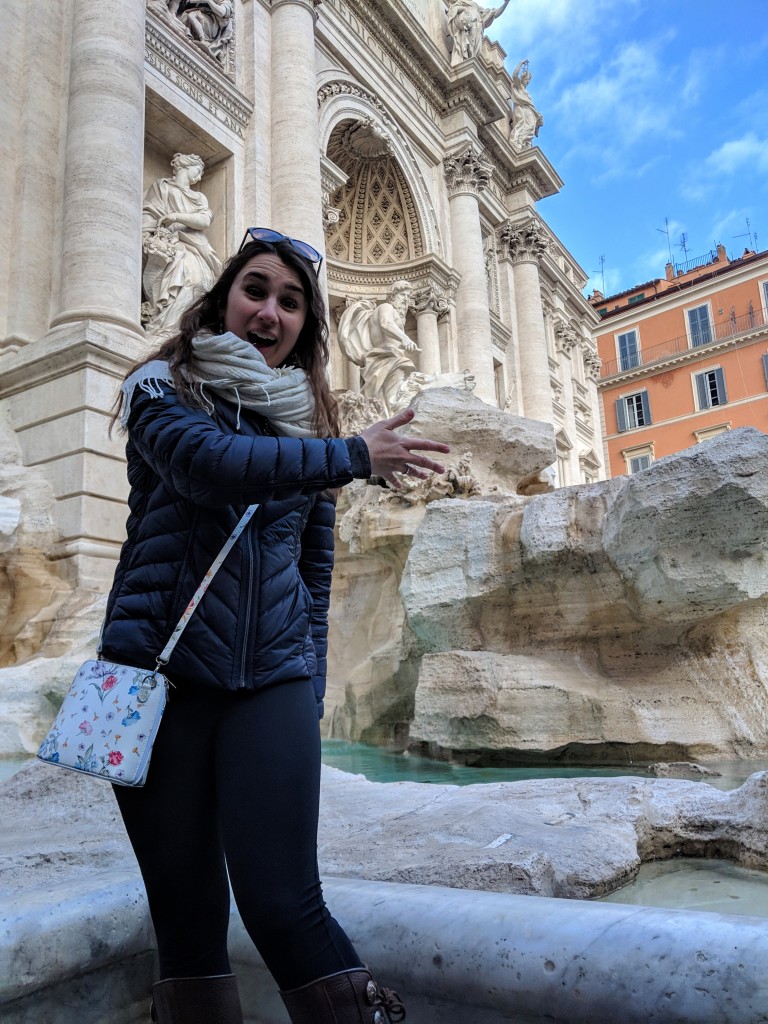
The Trevi Fountain was enormous. I was pessimistic about seeing it, expecting it to be a hyped up tourist attraction, but I have to admit I was impressed. The sculpture was almost two stories high in some places, and was beautifully crafted. The sheer amount of tourists present was just as impressive. It was a veritable mass of humanity. The fountain looked tranquil in comparison. People pressed up to the front to get selfies and toss coins into the water. Luckily the sides of the fountain had a bit more open space, so we go to get close enough to toss some coins in ourselves without too much body contact with strangers. The whole scene looked like pickpocket heaven. Before coming to Italy, we’d watched a short video about pickpockets in Italian cities. It completely changed our perception about how pickpockets worked. We’d seen a group of pickpockets in the Paris airport. A group of young women were hanging out outside baggage claim, and after being yelled at by an airport employee to get out or the police would be called, they moved onto the platform for the airport transport train. We watched as they cased potential victims, walking by them and bumping them to see if they’d notice. They got on our train, then off again. It was all so suspicious and obvious, and we thought that someone would have to be completely oblivious to be pickpocketed. How wrong we were. After watching the short documentary, we realized that those Parisian thieves had been a group of amateurs. Pickpockets can be so practiced at what they do, you can fully be prepared for it and still fall victim. Our sense of awareness heightened, we obsessively guarded our belongings. That didn’t stop us from pointing out to each other when we saw other tourists being careless with their effects…and the potential pickpockets who noticed the exact same thing. Crowds stayed just as thick as we approached the Spanish steps and the high-end shopping area. Climbing to the top, we enjoyed a panoramic view of the city as the sun set.
After a whirlwind day of touring the major sites of downtown Rome, we spent the evening wandering the streets of the Trastevere Neighborhood. We regretted not getting there earlier – the quaint, tiny streets were exactly the kind of atmosphere we were looking for. We stumbled onto the Basilica di Santa Maria, a beautiful church with a crypt open to visitors. We climbed down into the chill and walked across ancient Roman tiles.
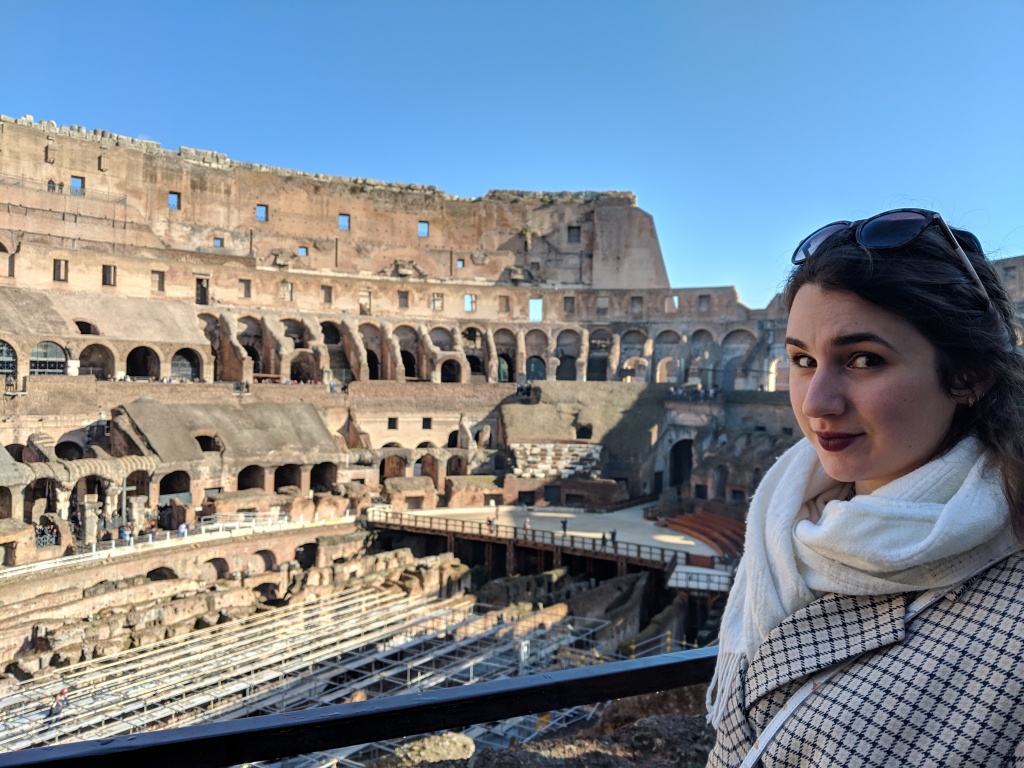
Rome during the Renaissance pretty much covered, it was time to delve into ancient history. The Colosseum is easily the most famous attraction in Rome. Built in 80 CE, it was the largest amphitheatre ever built and used for gladiator contests, animal hunts, executions, and grand spectacles like mock sea battles. It could hold up to 80,000 spectators, and the cheering and jeering would have been deafening. Over the centuries, it was used as a church, housing, fortress, even a quarry. In my opinion, it’s amazing so much of it is still standing today. As we approached the entry for the ticket booths, multiple touts came up to us offering us guided tours, which would “get us in much faster since the wait in line was about an hour or more”. We politely declined, and once inside found that the line was in fact no more than ten minutes long. Another bonus for the off season! Once inside, we were free to wander about. Restoration work meant that the arena itself was closed off for visitors, but I’m hopeful that it means one day tourists will be able to walk in the tunnels where the gladiators prepared to fight, and where the animals were kept before being lifted up through the floor with an ingenious pulley system. Museum-like exhibits showed us what the Colosseum would have looked like in its heyday. It was awe-inspiring to be inside one of the ancient wonders of the world, and it was certainly worth the ten minute wait.
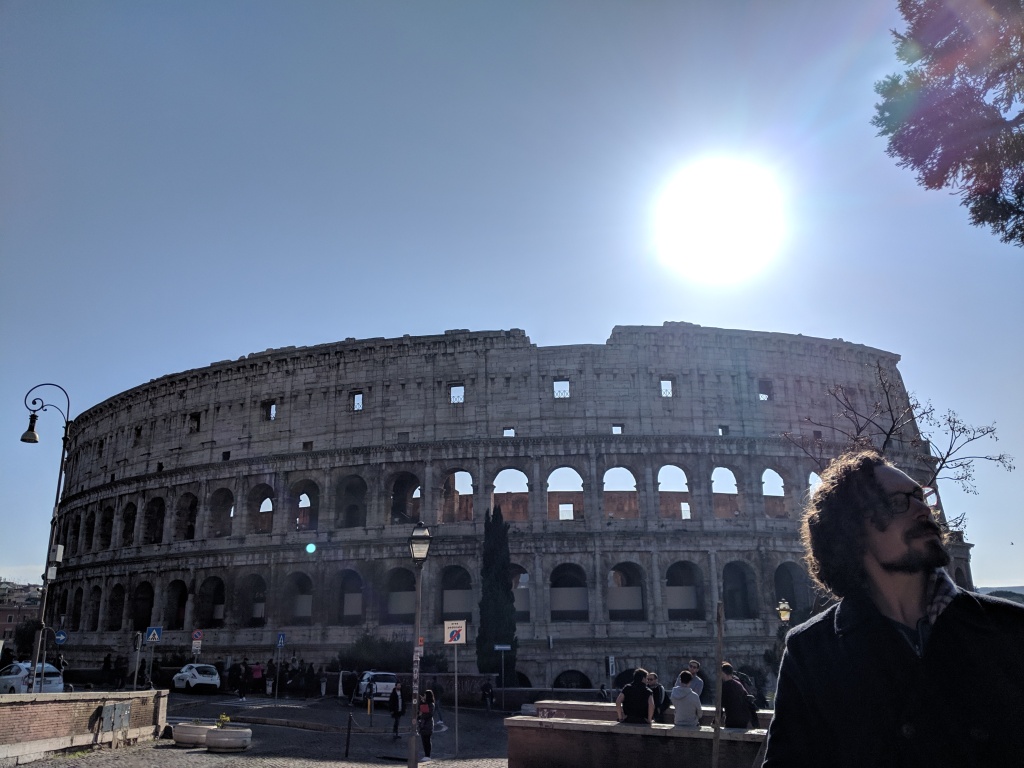
Our quick pasta lunch would have been nondescript, were it not for the gentleman eating behind us. He was clearly a local, and knew the restaurant staff quite well. He was tall and lean, and sat down for a meal unlike any I’d ever seen. As we struggled to complete two courses, he proceeded to tuck into full servings of oysters, pasta, chicken, salad, and dessert. All washed down with good wine, of course. We were in awe, and frankly, quite jealous. A traditional Italian meal consists of several courses, and they don’t skimp on any of them. Wondering how someone could eat like that and remain so fit, we looked into it and found out that many Italians won’t eat like that everyday. In fact, they might only eat like that two or three times a week. All other meals are much, much smaller. It’s something like “yo-yo dieting”, but worked into the culture. Put in our place by such magnificent eating, we went to the Roman Forum to walk off our pasta dish and three bites of chicken.
The Roman Forum was the heart of ancient Rome. Temples, government buildings, palaces… it was all there. And it’s all still there! We hurried inside, as evening was fast approaching and we wanted to see as much of it as possible. We popped in a Rick Steves audio tour, but got sidetracked and walked up a side alley to explore the ruins of a palace with great views over Circus Maximus, an ancient chariot racecourse. It also had a fantastic viewpoint of the Colosseum, which positively glowed in the setting sun. As we returned to the main area of the Forum, we had just enough time to see the market area which provided the inspiration for how Catholic cathedrals were built. Big, sweeping arches leading to smaller rooms on each side, with rows of columns down the center aisle. As we prepared to explore the temple area, we were ushered out by officials. The park was closing at sundown, and we had run out of time. The temples near the bottom of the hill would have to wait until our next visit to Rome.
We popped out at the Capitoline Hill, another iconic site of Rome. One of the seven hills of Rome, it now is covered in medieval and Renaissance palaces containing the Capitoline museums. Thoroughly exhausted and wary of approaching closing times, we opted to skip out on more museums and wander back home. With a tasty pit stop, of course.
A TASTE OF GELATO

After a long day of touring an Italian city, there is nothing quite like a cold cup of gelato. Gelato is an Italian-style ice cream that is smoother and silkier than our typical American counterpart. Contrary to what you’d think, it uses more milk and less cream than our ice cream, and no egg yolks. It gets its consistency by containing less air, keeping it rather dense so it feels creamy. This is how it can have less fat and still taste richer. Win, win! We’d seen hundreds of gelato shops by now and tried a cup or two in Florence, but we’d wizened up on how to pick the best scoop. First, look for natural colors. Pistachio-flavored gelato that doesn’t look like the Incredible Hulk’s bicep, for example. Strawberry-flavored gelato that doesn’t look like a melted MAGA hat (yuck, on so many levels). Pick something that looks like it’s homemade. Second, those impossibly high, artsy heaps of gelato with fancy decorations on top that just scream out for an Instagram photo-op? Forget it. With how hot Italy gets, the only way that the vendors can get the gelato to hold those high peaks without melting is with added chemicals. I’m sure there are other methods for picking good gelato, but even just focusing on passing over artificial colors and added chemicals meant we had some to-die-for gelato. Our favorite gelato shop in Rome was just kitty corner from Piazza Venezia. The server was a large Italian woman with a marquee name badge that flashed different colors. She claimed her gelato was the best in Rome, and she wasn’t wrong. We stopped there any time we were in the neighborhood.
VATICAN CITY
When in Rome, visiting the Vatican is a must. Vatican City is the seat of the Catholic Church and technically the smallest country in the world. It’s completely enclosed by Rome itself, but getting in wasn’t that complicated. Exiting the metro station, we followed the masses of tourists to the entrance to the Vatican Museums, the best way to start off a Vatican City tour.

The Vatican Museums are absolutely massive. It is one of the largest museums in the world, and contains works of Roman, medieval, and Renaissance art amassed by popes throughout the centuries. It’s pretty much built to guide people through in a long straight line, and we started on one end and began the slow museum-shuffle to the other side. The Vatican Museums have so many pieces of art in them, it’s impossible to take it all in. Curators didn’t even bother labeling everything. Which of course, left us wondering what monstrous statue a giant toe came from, among other bizarre pieces. We focused on some of the more famous pieces, such as Laocoön and His Sons, Apollo Belvedere, and the Belvedere Torso to name a few. Perhaps my favorite part of the Museums were near the end – the Raphael Rooms. These four palace reception rooms are where several of Raphael’s frescoes could be found. As a graduate of the University of Virginia and fiercely proud former-member of the band programs, I’m very familiar with Raphael’s School of Athens. A giant reproduction adorned our performance venue, Old Cabell Hall. It was extremely moving to see it in person, and we spent several minutes identifying figures Raphael included in the fresco, including Plato, Aristotle, Socrates, Ptolemy, and perhaps even his contemporary, Michelangelo.
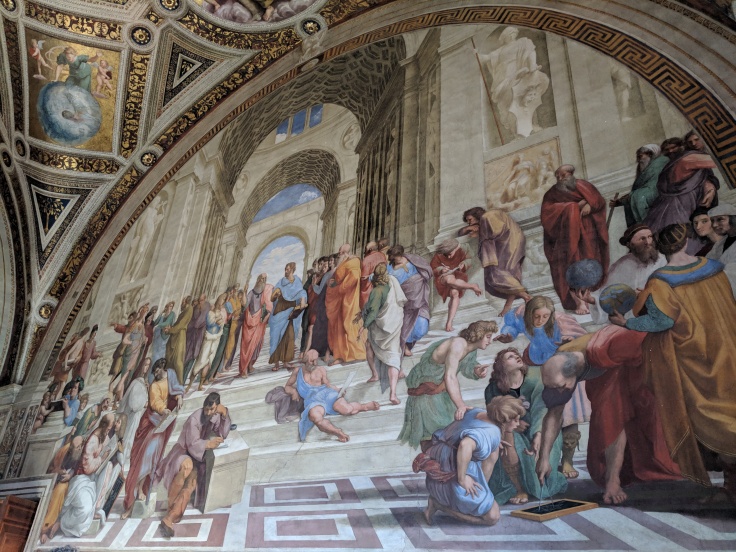
After the Raphael Rooms comes what is arguably the most famous destination in Vatican City – the Sistine Chapel. Stepping through a small door to the right of the altar, we found ourselves in a thick crowd of tourists with staff weaving in and out of the throng, constantly informing us to not take pictures and remain respectfully silent. Many, many tourists broke those rules during our visit, which is a shame, but not surprising. We gazed up at the ceiling Michelangelo painted over 500 years ago. It certainly deserves it’s fame, as it’s breathtaking. The scale alone is impressive, and it’s no wonder the artist developed back and neck pain as he worked from end to end. The frescoes depict scenes from the Book of Genesis, prophetic figures, and the Ancestors of Christ. Looking from one end of the ceiling to the other, you can see how Michelangelo reevaluated his style as he went. When he started, the scenes are more detailed, with smaller figures. It didn’t have the impact he wanted when viewed from ground level. So, as he continued, he began making large figures with sweeping movements, such as the iconic Creation of Man. Michelangelo also painted The Last Judgement on the wall behind the altar. It’s a bit darker than the other works in the Chapel, and was rather controversial when revealed. Some historians believe that at that point in his life, Michelangelo was getting rather cynical of church doctrine, and some of the demons even have the same faces as some of his critics. Nice one, Michelangelo.
When exiting the Sistine Chapel, most people are directed to the left. However, tour groups are allowed to go to the right, which is a shortcut to the front of St. Peter’s Basilica. It saves people from having to exit the Museums, walk around Vatican City, and then walk up the long, grand avenue that is St. Peter’s Square to get to the basilica. Although it’s just for tour groups, we snuck to the right for the short cut. If we’d been asked, we would have said that we were trying to catch up to our tour guide just ahead, but no one questioned us. Now, I’m not condoning this, but I’m just letting you know that it worked like a charm and saved us a ton of steps. Do with that information what you will.

Our Rick Steves Audio Guide told us to prepare ourselves to be amazed when we entered the church. We were skeptical – how different from all the other cathedrals we’d seen in Europe so far could it be? We were nearing “pretty church” burnout, definitely. We walked through the entry doors and took a spoonful of humble pie. Our mouths fell open. St. Peter’s Basilica is massive. There is no way pictures can do it justice. The nave seemed to go on forever before reaching the altar, and the ceiling was in the atmosphere. Approaching the altar, we saw markings on the floor indicated where other famous cathedrals would end if laid on top of St. Peter’s, including Notre Dame de Paris and the National Cathedral in Washington DC. Incredibly, the dome soars even higher than the ceilings around it, and it honestly felt like we might have well been outside looking at the sky. St. Peter’s is indeed the largest church in the world. Tradition states it’s also the burial site of Saint Peter, and his tomb is beneath the central altar (though inaccessible to tourists). We wandered about a bit in a daze, feeling as if we were in a small country. Which in fact, we were, but you get the idea. The artwork and chapels were also pleasant to look at, but the enormity of the church really stole the show for us. There was a really elaborate nativity scene set up in one of the chapels, which put every other one I’ve ever seen to shame. And I did really enjoy getting to see Michelangelo’s Pietà, though it’s now behind glass because some nutjob decided to go at it with a hammer. There’s always one.
It’s possible to climb the dome for an extra fee, but to my dismay it was a cash-only ticket. I was determined to climb it, so we exited the area and went in search for an ATM in Vatican City. As I reached into my wallet to get out my debit card to withdraw some cash, I found twenty Euros neatly tucked away. More than enough to climb the dome. We had exited the area and would need to go back through the long security line all for nothing. Consoling ourselves with astoundingly overpriced tourist food, we grumpily stood in line and made it back to the dome entrance. Clayton sat this one out, so I trooped up the many stairs to the top of St. Peter’s on my own.

The climb was nowhere near as far, nor as claustrophobic as the climb up Sacré-Cœur Basilica in Paris. Still, it wasn’t simple after so many pasta meals, and despite an elevator ride halfway up, I was huffing and puffing by the time I got to the first balcony. Unlike other cathedrals I’ve climbed, St. Peter’s has a viewing balcony on the inside of the dome. Stepping out into a caged walkway, I looked down onto the cathedral floor and watched people meandering about. They looked like ants. It somehow felt higher than if I was on a city building – the cavernous ceilings and echoes probably added to the effect. I saw Clayton and waved goofily until he saw me. Continuing up the dome, the stairs take visitors in a crawl space between the outer dome and inner dome, where the workers climbed around during construction. At the top of the dome, I could see across the entire country – sounds impressive, doesn’t it? It was a great viewpoint to see the Papal Apartments, Vatican Museums, St. Peter’s Square, and administrative buildings of Vatican City. I could also see the sprawling gardens that were closed for visitors. It was a stunning view, and worth the climb and extra euros. On the way down, visitors are directed across the roof of the nave, and can get up close and personal with the statues looking out over the square. There was even a little cafe and of course, a souvenir shop. Tourism will never change.
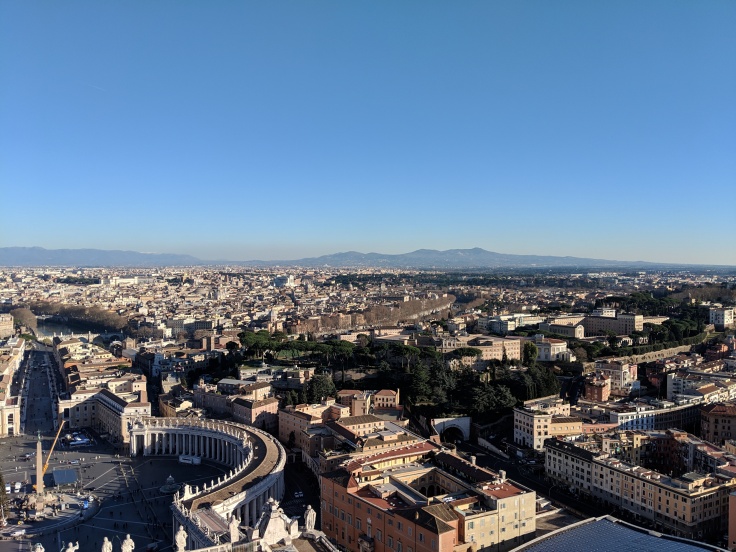
A WALK THROUGH TIME

On our final day in Rome, we wandered back towards the Colosseum and surrounding neighborhood. Waiting for our next attraction to open, we strolled through the local park, stumbling across some ancient Roman baths and ruins. The Colosseum was always visible between the buildings and trees, and glowed gold in the afternoon sun. Basking in the Roman sunlight was not in the cards for us, however. We were going on a walk through time. Basilica di San Clemente is a small, nondescript building near the Colosseum that is famous for it’s subterranean excavations. Excavations beneath the current church give it three levels – the current basilica built in the 1100s, a 4th-century basilica converted into a Roman nobleman’s house beneath that, and deepest into the ground, an ancient Roman, a temple to Mithraeum, and possibly a Roman mint. Paintings were being restored on the walls, bringing the damp stone walls to life. In the deepest part of our visit, the damp was so pervasive that a bright green moss was growing in large circles wherever a light was shining. The tiny hallways we stepped through would have been the narrow alleyways of ancient Rome. It was a fascinating visit, and should be on anyone’s itinerary for Rome.
Rome was what I expected it to be. It was magical to see such iconic pieces of history such as the Colosseum and the Roman Forum. But it was not so fun to be pressed in on all sides trying to get up to the Trevi Fountain. Rome was the beginning of the end of our patience for other tourists. It’s hypocritical, I know, but we were starting to get sick of the masses of other tourists taking pictures, ignoring the rules, and moving in large, oblivious groups. Rome has a severe tourist infestation, even in the off-season. It was harder for us to forget that we were tourists and imagine what it was like to be a local, especially when it seems that the local culture is catered to tourism out of necessity. Still, we got our unique moments, though few and far between. Our beaming gelato server with the flashing name tag. The pizza parlor two blocks from our AirBNB that we ate at every night and who started sneaking dessert pizza into our to-go boxes without charging us. The lean Italian man eating for twelve as we struggled through two delicious courses of our own. You may sense a pattern here – all our special moments are food related. But hey, when in Rome.


Thanks for sharing this with us! I miss Rome so much…and forgot how crowded the Trevi fountain gets!!
LikeLike
It’s pretty unreal – and the space doesn’t offer much wriggle room either!
LikeLiked by 1 person
Out of curiosity, did you prefer Florence or Rome?
LikeLike
Personally, I preferred Florence. It has a timeless elegance and it’s easier to get away from the tourist crowds in the city center. I also have keen interest in the Renaissance, and being it’s birthplace, Florence has a lot to offer on that front. Both cities have their advantages, but Florence is the one I want to return to!
LikeLiked by 1 person
Great post! Rome is my native city and it will always be very dear to me. I really liked reading your point of view on the city, it’s very interesting and it’s true that the less touristic areas are not really taken care of, which is a shame.
I have never tried American ice cream, I had no idea how different it was from Italian gelato!! I kinda want to try it now haha
Thanks for sharing!! 🙂
LikeLike
Thanks for reading! I will say although the less touristy areas weren’t as taken care of, that’s where we had the most unique experiences. I’m glad we were able to get a feel for modern Rome, and not just the ancient history!
You may feel quite let down by American ice cream. It’s not as rich and silky. Still good though!
LikeLiked by 1 person
Yes, that’s where you get a sense of the “real” life in Rome, and it’s great if you managed to see that as well! It’s always nice to wander a bit away from the touristic places.
Haha, maybe, but it’s definitely an experience and I’m sure it’s really good too! I’ll try it if I go to the US one day 🙂
LikeLike